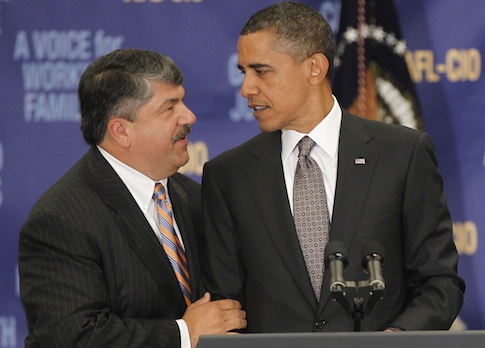Companies will be forced to disclose how many times more their Chief Executive Officers earn relative to rank and file employees, the result of a little known regulation in Dodd-Frank to be finalized later this year.
The provision is backed by labor unions like the AFL-CIO, which seeks to "shame companies into lowering CEO pay." The price tag of the regulation is expected to be "substantial," costing more than $72.7 million and over 500,000 hours to comply.
The "pay ratio disclosure rule," originally found in section 953(b) of the Dodd–Frank Wall Street Reform of 2010, requires all publicly traded companies to disclose the ratio of the CEO’s salary compared to the median salary of all employees at the company.
The Securities and Exchange Commission’s (SEC) proposed regulation would require the disclosure in a company’s annual report.
"For example, if the median of the annual total compensation of all employees of a registrant is $45,790.39 and the annual total compensation of a registrant’s [principal executive officer] PEO is $12,260,000, then the pay ratio disclosed would be ‘1 to 268’ (which could also be expressed narratively as ‘the PEO’s annual total compensation is 268 times that of the median of the annual total compensation of all employees’)," the proposed rule explains.
The median figure would factor in all employees earnings at a company, including part-time, seasonal, and temporary workers. Emerging growth companies with less than $1 billion in annual revenues, smaller reporting companies, and foreign private issuers would be exempt from the rule.
The final rule, which is expected in October, is drawing concerns from many corporations for being costly and "useless."
While publicly traded companies are already required to disclose their top executives’ pay, the new rule would require them to compile complex payroll, benefit, and pension data to determine the median salary of all their employees.
"It would take global companies months and thousands of hours to come up with a completely useless number," wrote the National Association of Corporate Directors (NACD), commenting on the proposal.
Others believe that the regulation "would not have any benefit, or, at most, would not have benefits sufficient to justify the compliance costs, which many of such commentators anticipate would be substantial," the SEC said.
The SEC said it would allow companies to determine their own metrics in reporting the ratio, by either statistical sampling, or "reasonable estimates." The agency said they are "sensitive to the costs" imposed by the regulation as a reason for added flexibility.
The regulation will still cost companies an estimated 545,792 paperwork hours, and $72,772,200 for the services of outside professionals. One business commenting on the proposal said the regulation would cost them $7.6 million and half the year to comply.
At the time of the proposed rule, the SEC was unsure what potential economic benefits, "if any," would be realized from requiring businesses to display how much less the median salary is compared to the CEO.
The regulation originated in a bill to "hold corporate executives accountable" sponsored by Sen. Bob Menendez (D., N.J.) in 2010. The legislation died in Congress but found its way into the Dodd-Frank law.
Menendez, along with other Senate Democrats including Elizabeth Warren, sent a letter to SEC Chair Mary Jo White last month urging the administration to move quickly on the rule.
"Because it has now been more than a year since the SEC issued its proposal and more than four years since the Wall Street Reform Act became law, we ask for your assurance that the SEC is still planning to finalize the rule in the very near future," they wrote in the letter dated Dec. 16. "In particular, we ask for your commitment to bring this rule before the Commission for a vote before the end of the first quarter of 2015."
The senators added that executives are sometimes valuable to companies.
"While CEOs can create value for companies, so can ordinary workers," they wrote. "Pay ratio disclosure helps investors evaluate the relative value a CEO creates, which facilitates better checks and balances against insiders paying themselves runaway compensation."
Menendez and Senate Democrats have the support of unions and liberal advocacy groups who believe the rule will fight income inequality.
"[T]his information clearly bears directly on the important public policy issues of pay equity and income inequality," wrote Americans for Financial Reform, an anti-Wall Street nonprofit led by Lisa Donner, a former SEIU union organizer and director of the "Financial Justice Center" at ACORN.
The group, along with the AFL-CIO, also wrote in a comment that they were hopeful the rule could limit CEO pay.
"More specifically, some of these commenters have suggested that the mandated disclosure requirement will encourage the boards of public companies to consider the relationship between the PEO’s compensation and the compensation of other employees, which, these commenters suggest could, in turn, curb excessive PEO compensation," the proposed rule said.
"CEO pay is out of control. But you can help rein it in," the AFL-CIO said on a website gathering comments to send to the SEC. "The Dodd-Frank Wall Street Reform and Consumer Protection Act requires companies to report their CEO-to-worker pay ratio to investors.
"Disclosing this pay ratio will shame companies into lowering CEO pay," they said.
